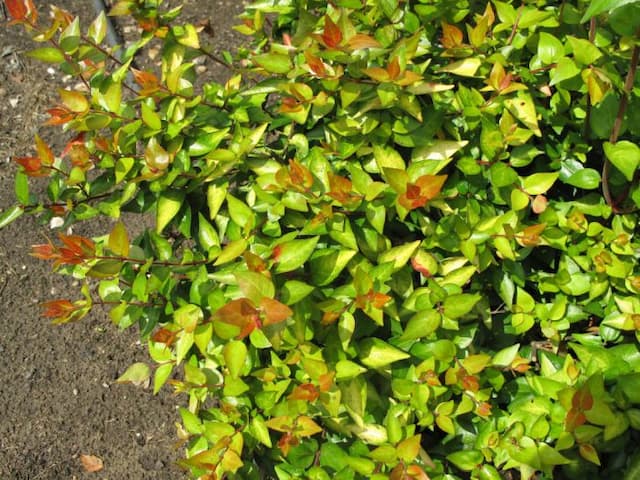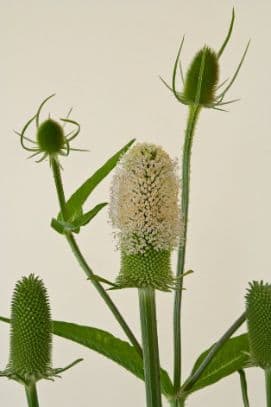Himalayan Honeysuckle Leycesteria formosa 'Purple Rain'

ABOUT
Leycesteria formosa 'Purple Rain', commonly known as Himalayan Honeysuckle or Pheasant Berry, is a striking deciduous shrub. Its appearance is characterized by an abundance of long, cascading flowering spikes. Each spike features small white flowers that are embraced by deep purplish bracts, giving the illusion of a gentle purple rainfall, which is where it gets its cultivar name 'Purple Rain'. The plant's foliage is attractive as well, made up of heart-shaped, soft green leaves that provide a lush backdrop for the flowers. Its stems are hollow and have a reddish-purple tinge, which complements the overall color scheme of the flowers and bracts. The individual flowers are quite delicate and tubular, which are often visited by hummingbirds and butterflies drawn to their sweet nectar. After the flowers, the plant produces small, shiny, deep purple to black berries that are popular with birds but are considered inedible for humans. These berries add to the ornamental value of the plant in the late season. Overall, Himalayan Honeysuckle 'Purple Rain' presents a wonderful display of color and form, with its pendulous flower spikes, attractive foliage, and eye-catching berries, creating a pleasing aesthetic in any garden space it inhabits.
About this plant
 Names
NamesFamily
Caprifoliaceae.
Synonyms
Himalayan Honeysuckle, Flowering Nutmeg, Himalaya Nutmeg, Pheasant Berry, Purple Rain.
Common names
Leycesteria formosa.
 Toxicity
ToxicityTo humans
Himalayan honeysuckle is generally considered non-toxic to humans, and there are no well-documented cases of poisoning from ingesting this plant. However, as with any plant, individual allergies and sensitivities can occur, so it is advisable to not consume parts of this plant unless you are certain it is safe for you to do so. If accidental ingestion does occur, monitor for any adverse reactions and consult a healthcare provider if any symptoms develop.
To pets
Himalayan honeysuckle is not commonly listed as a toxic plant to pets such as dogs and cats. While it does not contain any known toxic compounds that would pose a risk of significant toxicity, ingestion of plant material can potentially lead to gastrointestinal upset in some pets, manifested by symptoms such as vomiting or diarrhea. If your pet consumes a large amount of this plant and shows signs of distress, consult your veterinarian.
 Characteristics
CharacteristicsLife cycle
Perennials
Foliage type
Deciduous
Color of leaves
Green
Flower color
Purple
Height
6 feet (1.8 meters)
Spread
6 feet (1.8 meters)
Plant type
Shrub
Hardiness zones
7
Native area
Himalayas
Benefits
 General Benefits
General Benefits- Ornamental Value: 'Purple Rain' is known for its beautiful pendulous flower clusters, which are purple with white blooms, adding visual interest to any garden.
- Attracts Wildlife: It is a great attractor of pollinators such as bees and butterflies, aiding in the pollination of plants and contributing to biodiversity.
- Easy to Grow: This plant is recognized for its ease of cultivation, being tolerant of various soil types and capable of growing in both full sun and partial shade.
- Fast-Growing: 'Purple Rain' rapidly grows, making it an excellent choice for gardeners looking to quickly fill spaces.
- Low Maintenance: It requires minimal maintenance once established, only needing occasional pruning to maintain shape and encourage flowering.
- Drought Tolerance: Once established, it can tolerate periods of drought, making it suitable for gardens in drier climates.
- Seasonal Interest: Provides year-round interest with its changing foliage colors in the fall and attractive berries in the winter.
- Compatibility: Its non-invasive nature makes it a good neighbor to other plants, ideal for mixed borders or as a background shrub.
- Berries for Birds: Produces berries that are a food source for birds, supporting local wildlife.
- Privacy Screen: Its dense growth habit can be used for creating privacy screens or hedging in garden landscapes.
 Medical Properties
Medical PropertiesThis plant is not used for medical purposes.
 Air-purifying Qualities
Air-purifying QualitiesThis plant is not specifically known for air purifying qualities.
 Other Uses
Other Uses- Leycesteria formosa 'Purple Rain', commonly known as Himalayan honeysuckle, can be used in floral arrangements due to its attractive and vibrant flower clusters which add unique interest and texture to bouquets.
- The hollow stems of this plant can be used in garden projects as natural pea sticks or supports for climbing plants.
- The berries of Himalayan honeysuckle are sometimes used in making dyes due to their deep purple color, which can impart a natural hue to fabrics or craft materials.
- Because of its rapid growth, Himalayan honeysuckle can be cultivated as a temporary privacy screen in gardens where quick coverage is needed.
- Gardeners can utilize the plant in permaculture designs as a "chop and drop" species, providing green mulch to enrich the soil as it decomposes.
- The plant can be used in wildlife gardens to attract a variety of birds that feed on its berries, enhancing the biodiversity of the area.
- Its decorative woody stems can be utilized in woodworking or crafting projects, especially during the winter when they become more pronounced.
- In educational settings, Himalayan honeysuckle can be used to demonstrate invasive species management practices as it is known to spread in some regions.
- This plant can be used as a teaching tool for botany classes, showcasing pollination and seed dispersal methods through its interaction with birds and insects.
- For artistic inspiration, the contrasting colors and form of the Himalayan honeysuckle can be captured in paintings, drawings, or photography to highlight the beauty of nature.
Interesting Facts
 Feng Shui
Feng ShuiHimalayan honeysuckle is not used in Feng Shui practice.
 Zodiac Sign Compitability
Zodiac Sign CompitabilityHimalayan honeysuckle is not used in astrology practice.
 Plant Symbolism
Plant Symbolism- Invasiveness: Leycesteria formosa, commonly known as Himalayan Honeysuckle or Pheasant Berry, can be symbolic of unchecked growth or expansion, as it is known to be an invasive species in some regions, overpowering local flora.
- Attraction: With its deep purple-red bracts and sweet nectar, the plant can symbolize attraction and magnetism, much as it attracts pollinators like birds and bees to its flowers.
- Adaptability: Given its ability to thrive in a variety of conditions, Himalayan Honeysuckle can represent resilience and adaptability.
- Renewal: As a deciduous shrub that comes back each spring, it may symbolize rebirth and new beginnings.
 Water
WaterHimalayan honeysuckle prefers consistently moist soil, so it's important to water it thoroughly. Generally, watering once per week with about 1-2 gallons of water should be sufficient. However, during hot, dry periods, increased watering frequency to twice per week may be necessary. Ensure the top inch of soil is dry before rewatering to prevent overwatering. In winter, reduce watering but do not allow the soil to completely dry out.
 Light
LightHimalayan honeysuckle thrives in full sun to partial shade. A spot that offers morning sunlight and afternoon shade is ideal, particularly in areas with hot summers. If planted in too much shade, the plant may not flower as prolifically and can become leggy.
 Temperature
TemperatureHimalayan honeysuckle is hardy and can tolerate a range of temperatures, generally from 20°F to 85°F. It performs best when the temperature is between 60°F and 75°F. This plant can survive light frosts but may not withstand prolonged periods of severe cold below 20°F.
 Pruning
PruningPruning Himalayan honeysuckle promotes healthy growth and rejuvenates the plant. Prune in late winter or early spring before new growth starts. Remove any dead or damaged wood and trim back to maintain shape. Cutting back hard every couple of years can help to encourage more vigorous growth. The best time to prune is when the plant is dormant.
 Cleaning
CleaningAs needed
 Soil
SoilHimalayan Honeysuckle 'Purple Rain' prefers well-draining soil rich in organic matter with a pH between 6.5-7.5. A mix containing loamy garden soil, peat, and perlite or sand is ideal to ensure proper drainage and fertility.
 Repotting
RepottingHimalayan Honeysuckle 'Purple Rain' generally does not require frequent repotting and can be repotted every 2-3 years, or when it outgrows its current container.
 Humidity & Misting
Humidity & MistingHimalayan Honeysuckle 'Purple Rain' tolerates a wide range of humidity levels but thrives best in moderate to high humidity conditions, avoiding excessively dry atmospheres.
 Suitable locations
Suitable locationsIndoor
Place in bright, indirect light and water when top soil is dry.
Outdoor
Plant in partial shade to full sun and ensure soil is moist but well-drained.
Hardiness zone
7-10 USDA
 Life cycle
Life cycleHimalayan Honeysuckle 'Purple Rain' begins as a seed, which, once sown, germinates to sprout a young seedling. The seedling then grows into a juvenile plant, establishing a root system and beginning to develop stems and leaves in its first growing season. As it enters maturity, the plant produces tall, hollow stems with opposite leaves and distinctive purplish-red bracts, eventually flowering in late spring to summer with white flowers that are attractive to pollinators like bees and butterflies. After pollination, the flowers give way to shiny, purplish-black berries that are enjoyed by birds throughout summer and into fall. In colder regions, the plant may die back to the ground over winter but will resurge from the roots in spring. Throughout its life, the Himalayan Honeysuckle may also spread vegetatively by rooting at stem nodes when they touch the ground or by self-seeding if conditions are favorable.
 Propogation
PropogationPropogation time
Spring-Summer
Himalayan Honeysuckle 'Purple Rain', known scientifically as Leycesteria formosa 'Purple Rain', is most commonly propagated through semi-hardwood cuttings. This method is typically undertaken in late summer after the plant has finished flowering. Cuttings should be about 4 to 6 inches long, with a few leaves left at the top. It's important to cut just below a node, which is the point on the stem where leaves are attached, as this is where the roots will develop from. The cuttings can then be dipped in rooting hormone, which is not necessary but can help stimulate root growth, and planted in a well-draining soil mixture. Maintaining humidity around the cuttings by using a plastic cover can create a conducive environment for rooting. Under proper conditions, the cuttings will take root in a few weeks, after which they can be gradually acclimated to less humid conditions and eventually planted out in the garden.








